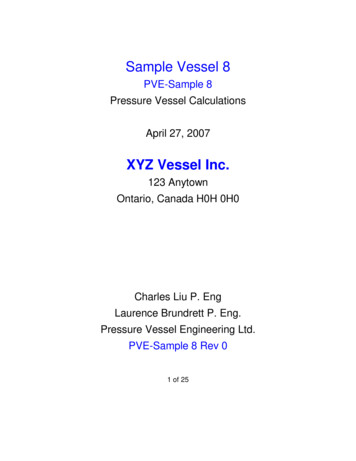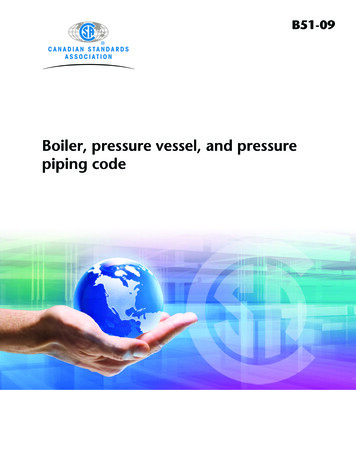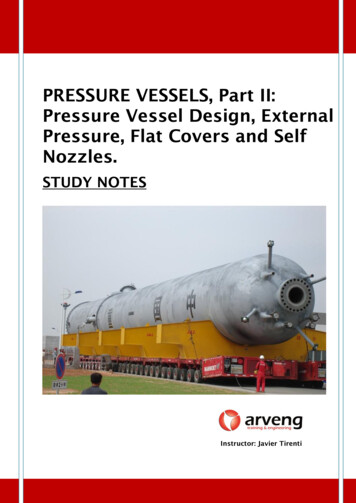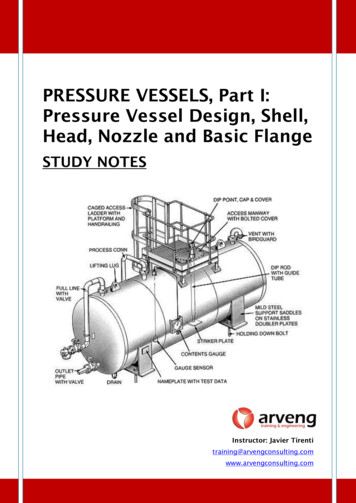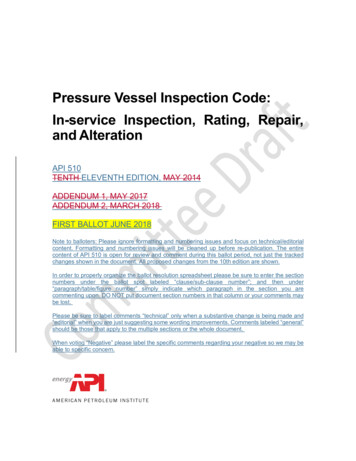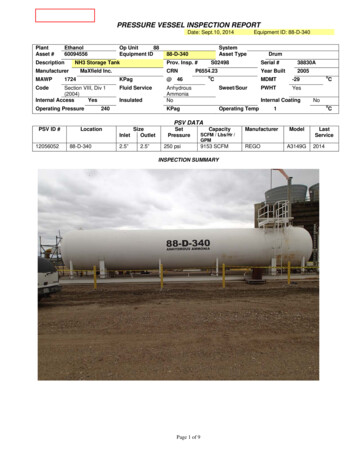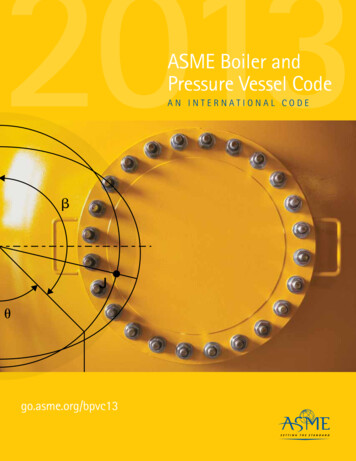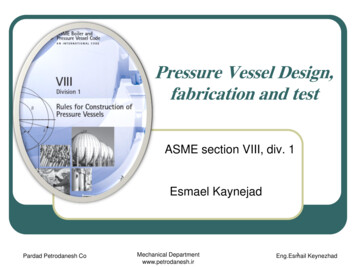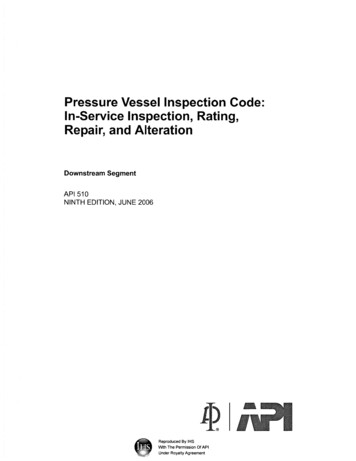
Transcription
Pressure Vessel Inspection Code:In-Service Inspection, Rating,Repair, and AlterationDownstream SegmentAPI 510NINTH EDITION, JUNE 20061) Reproduced By IHSWrth The Permission Of APIUnder Royalty Agreement
SPECIAL NOTESAPI publications necessarily address problems of a general nature. With respect to particularcircumstances, local, state, and federal laws and regulations should be reviewed.Neither API nor any of API's employees, subcontractors, consultants, committees, or otherassignees make any warranty or representation, either express or implied, with respect to theaccuracy, completeness, or usefulness of the information contained herein, or assume anyliability or responsibility for any use, or the results of such use, of any information or processdisclosed in this publication. Neither API nor any of API's employees, subcontractors, consultants, or other assignees represent that use ofthis publication would not infringe upon privately owned rights.API publications may be used by anyone desiring to do so. Every effort has been made bythe Institute to assure the accuracy and reliability of the data contained in them; however, theInstitute makes no representation, warranty, or guarantee in connection with this publicationand hereby expressly disclaims any liability or responsibility for loss or damage resultingfrom its use or for the violation of any authorities having jurisdiction with which this publication may conflict.API publications are published to facilitate the broad availability of proven, sound engineering and operating practices. These publications are not intended to obviate the need forapplying sound engineering judgment regarding when and where these publications shouldbe utilized. The formulation and publication of API publications is not intended in any wayto inhibit anyone from using any other practices.Any manufacturer marking equipment or materials in conformance with the markingrequirements of an API standard is solely responsible for complying with all the applicablerequirements of that standard. API does not represent, warrant, or guarantee that such products do in fact conform to the applicable API standard.All rights reserved. No part o/this work may be reproduced, stored in a retrieval system, ortransmitted by any means, electronic, mechanical, photocopying, recording, or otherwise,without prior written permission from the publisher. Contact the Publisher,API Publishing Services, I220 L Street, N W, Washington, D. C. 20005.Copyright 2006 American Petroleum Institute
FOREWORDIn December 1931, API and the American Society of Mechanical Engineers (ASME) created the Joint APIIASME Committee on Unfired Pressure Vessels. This committee was created to formulate and prepare for publication a code for safe practices in the design,construction, inspection, and repair of pressure vessels to be used in the petroleum industry.Entitled APIIASME Code for Unfired Pressure Vessels for Petroleum Liquids and Gases(commonly called the API/ASME Code for Unfired Pressure Vessels or API/ASME Code),the first edition of the code was approved for publication in 1934.From its inception, the APIIASME Code contained Section I, which covered recommendedpractices for vessel inspection and repair and for establishing allowable working pressuresfor vessels in service. Section I recognized and afforded well-founded bases for handlingvarious problems associated with the inspection and rating of vessels subject to corrosion.Although the provisions of Section I (like other parts of the API!ASME Code) were originally intended for pressure vessels installed in the plants of the petroleum industry, especially those vessels containing petroleum gases and liquids, these provisions were actuallyconsidered to be applicable to pressure vessels in most services. ASME's Boiler and Pressure Vessel Committee adopted substantially identical provisions and published them as anonmandatory appendix in the 1950, 1952, 1956, and 1959 editions of Section VIII of theASME Boiler and Pressure Vessel Code.After the APIIASME Code was discontinued in 1956, a demand arose for the issuance ofSection I as a separate publication, applicable not only to vessels built in accordance withany edition of the APIIASME Code but also to vessels built in accordance with any editionof Section VIII of the ASME Code. Such a publication appeared to be necessary to assureindustry that the trend toward uniform maintenance and inspection practices afforded bySection] of the API! ASME Code would be preserved. API 510, first published in 1958, isintended to satisfY this need.The procedures in Section] of the 1951 edition of the APIIASME Code, as amended by theMarch 16, 1954 addenda, have been updated and revised in API 510. Section I of the API!ASME Code contained references to certain design or construction provisions, so these references have been changed to refer to provisions in the AS ME Code. Since the release of the1960 edition of the National Board Inspection Code, elements of the APlIASME Code havealso been carried by the National Board Inspection Code.It is the intent of API to keep this publication up to date. All pressure vessel owners andoperators are invited to report their experiences in the inspection and repair of pressure vessels whenever such experiences may suggest a need for revising or expanding the practicesset forth in API 510.This edition of API 510 supersedes all previous editions of API 510. Each edition, revision,or addenda to this API standard may be used beginning with the date of issuance shown onthe cover page for that edition, revision, or addenda. Each edition, revision, or addenda tothis API standard becomes effective 6 months after the date of issuance for equipment that isrerated, reconstructed, relocated, repaired, modified (altered), inspected, and tested per thisstandard. During the 6-month time between the date of issuance of the edition, revision, oraddenda and the effective date, the user shall specifY to which edition, revision, or addenda,and the equipment is to be rerated, reconstructed, relocated, repaired, modified (altered),inspected and tested.Nothing contained in any API publication is to be construed as granting any right, by implication or otherwise, for the manufacture, sale, or use of any method, apparatus, or productcovered by letters patent. Neither should anything contained in the publication be construedas insuring anyone against liability for infringement of letters patent.iii
This document was produced under API standardization procedures that ensure appropriatenotification and participation in the developmental process and is designated as an API standard. Questions concerning the interpretation of the content of this publication or commentsand questions concerning the procedures under which this publication was developed shouldbe directed in writing to the Director of Standards, American Petroleum Institute, 1220 LStreet, N.W., Washington, D.C. 20005. Requests for permission to reproduce or translate allor any part of the material published herein should also be addressed to the director.Generally, API standards are reviewed and revised, reaffirmed, or withdrawn at least everyfive years. A one-time extension of up to two years may be added to this review cycle. Statusof the publication can be ascertained from the API Standards Department, telephone (202)682-8000. A catalog of API publications and materials is published annually and updatedquarterly by API, 1220 L Street, N.W., Washington, D.C. 20005.Suggested revisions are invited and should be submitted to the Standards and PublicationsDepartment, API, 1220 L Street, NW, Washington, DC 20005, standards@api.org.
INSTRUCTIONS FOR SUBMITTING A PROPOSED REVISION TOTHIS STANDARD UNDER CONTINUOUS MAINTENANCEThis standard is maintained under APT's continuous maintenance procedures. These procedures establish a documented program for regular publication of addenda or revisions,including timely and documented consensus action requests for revisions to any part of thestandard. Proposed revisions shall be submitted to the Director, Standards Department, API,1220 L Street, NW, Washington, D.C. 20005-4070, standards@api.org.
CONTENTSPageSCOPE .1.1 General Application .I .2 Specific Applications .1.3 Recognized Technical Concepts .1-11-1I-I1-22REFERENCES . 2-13DEFINITIONS . 3-14OWNERIUSER INSPECTION ORGANIZATION . 4-14.1 General. . .4-14.2 Owner/user Organization Responsibilities . 4-15INSPECTION, EXAMINATION AND PRESSURE TESTING PRACTICES . 5-15.1 Inspection Plans . 5-15.2 Risk-based Inspection (Rbi) . 5-15.3 Preparation For Inspection . 5-25.4 Inspection For Types Of Damage Modes Of Deterioration And Failure . 5-35.5 General Types Oflnspection And Surveillance . 5-45.6 Condition Monitoring Locations . 5-75.7 Condition Monitoring Methods . 5-75.8 Pressure Testing . 5-95.9 Material Verification And Traceability . 5-105.10 Inspection Ofln-service Welds And Joints . 5-115.11 Inspection Of Flanged Joints . 5-116INTERV ALiFREQUENCY AND EXTENT OF INSPECTION . . . . . . . . . . . . . . 6-16.1 General . 6-16.2 Inspection During Installation And Service Changes . 6-16.3 Risk-based Inspection . 6-16.4 External Inspection . 6-16.5 Internal And On-stream Inspection . 6-26.6 Pressure-relieving Devices . 6-37INSPECTION DATA EVALUATION, ANALYSIS, AND RECORDING . 7-17.1 Corrosion Rate Determination . 7-17.2 Remaining Life Calculations . 7-17.3 Maximum Allowable Working Pressure Determination . 7-27.4 Fitness For Service Analysis Of Corroded Regions . 7-27.5 API RP 579 Fitness For Service Evaluations . 7-37.6 Required Thickness Determination . 7-47.7 Evaluation Of Existing Equipment With Minimal Documentation . 7-47.8 Reports And Records . 7-58REPAIRS, ALTERATIONS, AND RERATING OF PRESSURE VESSELS . 8-18.1 Repairs And Alterations . 8-18.2 Rerating . 8-7v
CONTENTSPage9ALTERNATIVE RULES FOR EXPLORATION AND PRODUCTION PRESSUREVESSELS. . . . . . . . . . . . . . . . . . . . . . . . . . . . . . . . . . . . . . . . . . . . . . . . . . . . . . . . . . 9-19.1 Scope And Specific Exemptions . 9-19.2 Definitions . 9-19.3 Inspection Program . 9-19.4 Pressure Test. . 9-49.5 Safety Relief Devices . 9-49.6 Records . 9-4APPENDIX AAPPENDIX BAPPENDIX CAPPENDIX DASME CODE EXEMPTIONS . A-IINSPECTOR CERTIFICATION . B-1SAMPLE PRESSURE VESSEL INSPECTION RECORD . C-ISAMPLE REPAIR, ALTERATION, OR RERATING OFPRESSURE VESSEL FORM . D-lAPPENDIX E TECHNICAL INQUIRIES . E-ITables7-1 Values of Spherical Radius FactorK] . 7-48-1 Welding Methods as Alternatives to Postweld Heat Treatment QualificationThickness for Test Plates and Repair Grooves. . . . . . . . . . . . . . . . . . . . . . . . . . 8-7Figures8-1 Rerating Vessels Using the Latest Edition or Addendum of the ASME CodeAllowable Stresses . 8-9
Pressure Vessel Inspection Code: In-Service Inspection, Rating, Repair,and Alteration1Scope1.11.1.1General ApplicationCoverageThis inspection code covers the in-service inspection, repair, alteration, and rerating activities for pressure vessels and the pressure-relieving devices protecting these vessels. This inspection code applies to all refining and chemical process vessels that havebeen placed in service unless specifically excluded per 1.2.2. This includes:a. vessels constructed in accordance with an applicable construction codeb. vessels constructed without a construction code (non-code)-A vessel not fabricated to a recognized construction code andmeeting no known recognized standardc. vessels constructed and approved as jurisdictional special based upon jurisdiction acceptance of particular design, fabrication,inspection, testing, and installationd. non-standard vessels-A vessel fabricated to a recognized construction code but has lost it's nameplate or stamping.The ASME Code and other construction codes are written for new construction; however, most of the technical requirements fordesign, welding, NDE, and materials can be applied to the inspection, rerating, repair, and alteration of in-service pressure vessels.If an item cannot follow the ASME Code because of its new co
tion, and inspection shall conform to API 510 rather than to the ASME Code. If in-service vessels are covered by requirements in the ASME Code and API 510 or if there is a conflict between the two codes, the requirements of API 510 shall take precedence. API . API! vessel. PRESSURE VESSEL INSPECTION CODE: IN-SERVICE INSPECTION, RATING, REPAIR, AND ALTERATION . the: 1 .
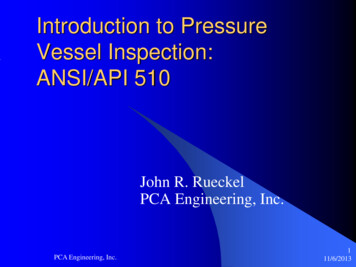
![API Ballot: [Ballot ID] – API 510 & API 570, Deferrals, Rev05](/img/5/api510andapi570deferralsrev5.jpg)
